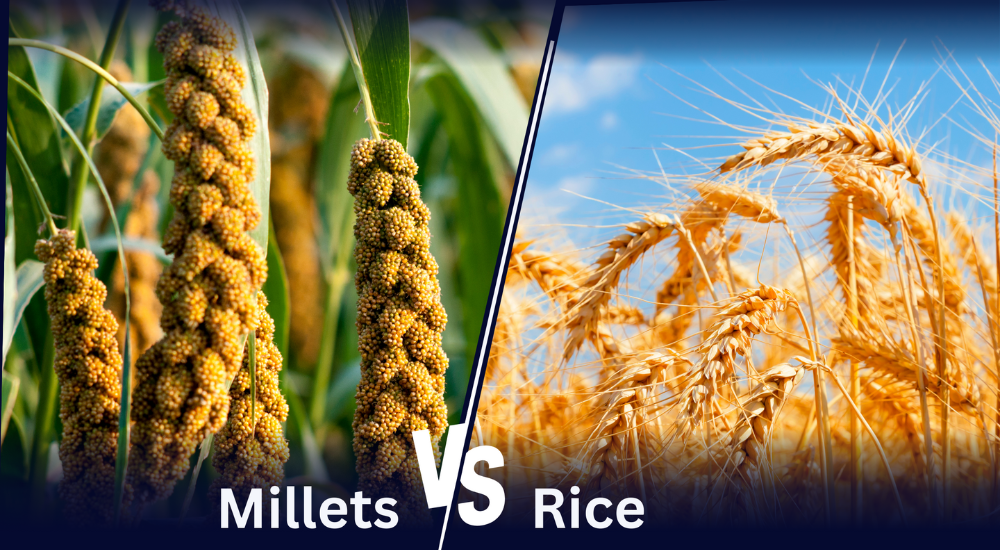If you've ever wondered “millet or rice – which is better?”, you're not alone. As more people become health-conscious and look for nutritious alternatives to refined grains, millets have emerged as a powerful superfood and a worthy replacement for rice.
Often underutilized in modern diets, millets are ancient grains packed with fiber, protein, and essential nutrients. Compared to rice, millets deliver higher nutritional value, better blood sugar control, and improved gut and heart health — making them a top choice for those aiming for a balanced, sustainable lifestyle.
In this blog, we’ll explore the benefits of millets over rice and help you understand why millets are healthier than rice for your everyday meals.
Millet vs Rice, Know advantages of millets over rice :
1. Millets are high in fiber – Supporting Digestion & Gut Health
One of the top benefits of millets over rice is their higher fiber content. Millets contain over 3x more fiber than white rice.
For every 100g, millets contain 1.3g of fiber in comparison to 0.4g of fiber in rice. This higher fiber content in millets not only helps you meet your daily fiber needs but also maintains your blood sugar levels, assists digestion and maintains good intestinal health.
2. Millets have a low glycemic index:
With a lower glycemic index than rice, millets are a healthier choice for people who are controlling their blood sugar and diabetes.
3. Millets contain complex carbohydrates:
Unlike rice, which has mostly simple carbs, millets are rich in complex carbohydrates that take longer to digest.
Complex carbohydrates in millets enable slow digestion. This helps in the gradual and sustained release of energy, thus keeping you feel fuller for a longer period, and supporting your metabolism health.
4. Millets are a source of high protein:
Wondering “is millet healthier than rice in terms of protein?” Yes — millets have more protein per serving
For every 100g, millets have 3.51g of protein as opposed to 2.69g in rice. A higher quantity of protein ensures muscle growth and repair, supporting metabolism health, as well as weight management.
5. Millets improve cardiovascular health:
As millets contain higher nutritional benefits than rice, including high fiber, and iron they help lower cholesterol levels and type-2 diabetes, reducing the risk of cardiovascular health issues.

How to Start Replacing Rice with Millets in Your Diet
Integrating millets is simple, thanks to versatile staples from Haritha Foods:
- Millet Khichdi Mix – Balanced comfort food with dal and whole spices
- Millet Dosa Mix – Fermented, protein-rich and gut-friendly
- Sprouted Ragi Porridge – Ideal for breakfast or baby food
- Jowar Soup Mix – Light yet nourishing evening option
- Little Millet Rava & Mixed Millet Flour – Great for upma, idlis or baking
These ready-to-cook products help you switch from rice to millets without compromising on taste.
Millets do not just stand out as a better nutritional alternative to rice but also support sustainable agriculture. Their versatility makes them a culinary star, that offers healthy recipes for both children and adults. As a superfood, millets cater to those with specific dietary requirements, weight loss, and health goals, making them an exciting change without compromising on your taste palette.
Conclusion: Millet or Rice – Which Is Better?
In every major category — nutrition, digestion, blood sugar control, protein content, and sustainability millets outperform rice. Whether you're managing weight, improving gut health, or simply seeking cleaner, plant-based nutrition, millets are the superior grain.
At Haritha Foods, we are committed to providing you with premium quality unpolished millet-based products such as millet staples, Gluten free foods options that not only taste delicious but also contribute to your well-being. Our unique dry roast technique ensures that the natural flavors and nutrients of millets are preserved, delivering a wholesome and nourishing experience with every bite.
Also Explore the different types of millet varieties available in India to discover unique flavours and nutritional benefits & also Make the switch to millets today.


